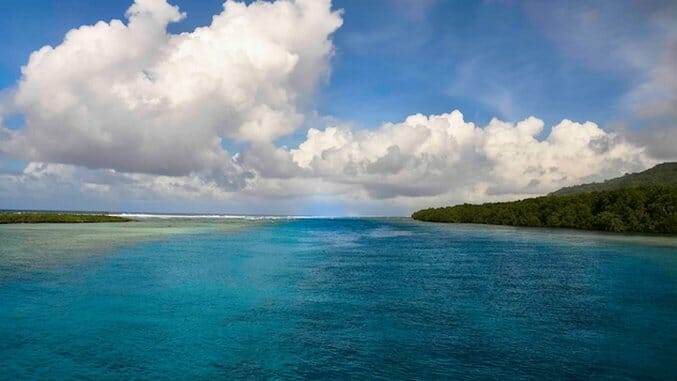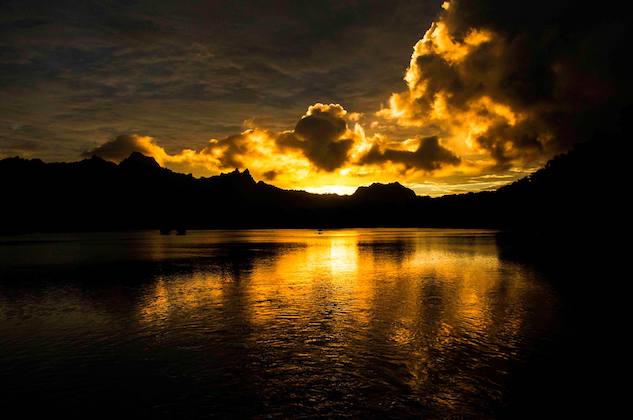
It seems like very few people have heard of Micronesia. “You mean Indonesia?” They ask. Not quite. The Federated States of Micronesia is a cluster of islands in the massive stretch of ocean between Hawaii and Australia, right next to Guam. Keen divers might have heard about Chuuk, famous for its World War II wreck dives, but few have ventured as far as the beautiful, largely untouched island of Kosrae, known as the jewel of Micronesia.
Only the most adventurous travelers turn up in Kosrae, an island of around 7,000 people, two main hotels and approximately 200,000 coconut palms. In a world of increasing commercialization, Kosrae really is an adventure-loving traveler’s dream. The island offers a very personalized “homey” travel experience. With very few expats and a small town atmosphere, everyone is incredibly welcoming; you feel like part of the community immediately on this virtually untouristed island. As everything is family run and flexible, you have the freedom to choose your own adventure and go at your own pace. Everyone will do their best to make sure you have a great time and see the best their island has to offer.
Kosrae is a little tricky to get to, but well worth the effort. You’ll need to island hop from Hawaii, but there are regular flights with United Airlines. Micronesia uses the U.S. dollar, making the island an accessible holiday destination. All equipment rentals (with the exclusion of high quality surfboards) and tours can be organized through the island’s two main hotels: Kosrae Nautilus Resort and Pacific Treelodge Resort.
Here is just a smattering of itinerary ideas for this gorgeous volcanic speck in the middle of the Pacific.
1. Diving and Snorkeling
Kosrae is surrounded by a fringing reef, meaning there are dive sites everywhere. And, as the island gets very few tourists, they are uncluttered with fellow divers. Around many other islands famous for fish and coral, you can be in the water with tens of others, making it feel like an aquarium full of people all trying to get a glimpse of the same poor crustacean or octopus just trying to go about their business uninterrupted. Not here. More often than not, your group—which could be just you and the instructor—is the only one in the water.
You can see most of the stuff you’d see diving up close and personal with just a snorkel and a mask. Sharks included. All you have to do is walk in a straight line out from the beach almost anywhere on the island. Best of all, it’s free.
2. Surfing

Kosraens, in general, don’t surf. While there are a few local children who could put even professional surfers to shame, the island’s perfect waves remain largely untouched. Forget the overcrowded waves of other surfing hotspots; if you are an experienced board rat and want a world-class (if sometimes fickle) surfing adventure, Kosrae is the place for you.
Local knowledge however, is a must. Your hotel will get in touch with locally based surf guides on your behalf. Most of the best waves are on the island’s west side. Designed specifically to keep numbers down, you’ll need a permit and a boat to access these waves, but they’re worth it. There are decent breaks outside the reserve, accessible by a short paddle out to clean, peeling reef break lines.
You’ll need to bring your own board; while the hotels could probably rustle up one for you by calling around the local surfers, why take the risk and miss out on some of the most epic waves you’ll ever encounter? Kosrae has rights and lefts, long walls and stand-up barrels. The surf season is from October to March.”
3. Eating
All those tuna you see when you go diving are ridiculously cheap to eat. About $20 bought us an arm-sized tuna and two lobsters; all we had to do was figure out how to gut them and cook them. Luckily, fresh caught tuna, reef fish, crab and lobster is available on every menu. You’ll never get better sashimi.
You can also try Sakau, the local drink. Sakau is the Kosraen term for Kava, the mildly narcotic brew famous all across the Pacific. Kosrae is known for having the best and strongest Sakau in the region, which essentially means it’s the best in the world. It looks and tastes like muddy water, but produces quite a pleasant fog when sipped slowly with friends. Originally used for spiritual or royal rituals, Sakau can now be sampled at one of the handful of dens across the island.
4. Yela Ka Forest
Going to an island to see some trees may sound a bit ridiculous. But then you haven’t seen the Ka trees of Kosrae in the only remaining Ka forest in the world.
You arrive at the Yela Ka Forest by boat, with one of the family members traditionally responsible for the land serving as your guide. The journey takes you in over the open sea, through the mangroves in an increasingly tiny channel until you reach a small jetty in the middle of the massive Ka grove. Ka trees are impressive. Straight and tall with pale trunks, their large roots sprout out a few feet above the ground, looking like giant elbows. They provide a thick canopy, creating an otherworldly landscape beneath them. It’s pretty awe-inspiring; knowing that this is unique, that there is no other place like it and you have it all to yourself is truly an incredible feeling.
5. History
Kosrae hosts ruins of a huge fortress and spiritual village dating back over a thousand years. Quirkily, the main complex is in downtown Kosrae, right behind the only supermarket. The Lelu ruins are the royal complex, built of massive basalt blocks. It’s a complete mystery how it was built. But “ancient” is not the only type of history this tiny island boasts; Japanese relics from WW2 also dot the entire island.
Randomly, pirates also visited little Kosrae. The most famous is the dreaded American William “Bully” Hayes, who terrorized the world from the Caribbean to the Pacific. He used Kosrae as a hideout, eventually losing both his ship and his treasure in its waters. The wreck of his beloved ship Leonora is still in Utwe Harbour, and artifacts retrieved from it can be viewed in Kosrae’s tiny but informative state museum. His treasure has never been found, but there are a lot of rumors surrounding it. From a crab that was supposedly discovered with a gold coin in its claw to the Japanese tourist who went diving and returned home with sudden riches, the legend of Bully’s treasure continues.
6. Kayaking and Stand Up Paddle Boarding

Kosrae is criss-crossed with mangrove and coral-filled channels. Some, rather uniquely, have both. There are no dangerous animals or large sea creatures on Kosrae. No crocodiles or alligators, only the harmless and very shy reef sharks out past the drop off. So, if you’re like us and can get freaked out if you think too much about what might be in the water with you, Kosrae is pretty perfect water sports-wise. The water in the channels is perfectly clear, so you can see straight down to the bottom. If you take a packed lunch, paddling through the waterways is a perfect way to spend a lazy day or two. You can also head out to the Blue Hole and spy on the teeming Finding Nemo sea life from your perch above the waves. If you’re up for an adventure, you can even kayak or paddle the whole way around the island.
7. Hiking
From a gentle family style walk to full on bush whacking, Kosrae has a hike for everyone. There are dozens of hikes to choose from—from mountains to waterfalls, ruins to World War Two relics. Kosrae is known as the “Island of the Sleeping Lady” because its mountain ranges look like, well, a sleeping lady. And you can climb every one of her, ah, mounds. The Mt. Oma hike is a great example; at 1555 feet, it is the island’s second highest peak, and takes about six hours to climb, depending on your pace. You can explore Japanese tunnels from the Second World War as you make your way up to the summit. One step off the path can get you lost for hours, but it’s ok because nothing on Kosrae can kill you. The locals will find you, eventually.
8. Sunset Cruise

A favorite among Kosrae’s expats, Pacific Treelodge Resort organizes a weekly sunset cruise around Utwe Harbour, complete with beer, soft drinks and freshly prepared local snacks. It’s a lovely chance to kick back with Mark, an American diving instructor who has managed Pacific Treelodge for years, listen to his stories about Kosrae and watch the sun set between the breasts of the sleeping lady. We mean the mountain; don’t be creepy.
9. Fishing
Sounds boring, right? Something old men do. Slow and dull. Not here on Kosrae where they spear fish. Correction: they machete fish. Or for those looking for something a little more docile, you can relax on a boat with your fishing line dangling off the side. The local fishing rod is simply a line and hook wrapped around a beer bottle. Who needs anything more fancy than that?
If you sign up for an assisted spear fishing tour, your local guide will show you the ropes, then take you out to collect your own fresh seafood. The beautiful coral is a bonus. But why stop at reef fish when a bevy of pelagic bounty is literally jumping out of the water? Marlin, tuna, skipjack and barracuda make the fishing around Kosrae some of the best in the world. Afterwards your haul will be prepared for you to feast on and brag about to your friends back home.
Luisa Ryan is a Brisbane, Australia-based writer, who when not playing with her six-month-old, is completing a Ph.D in political science.